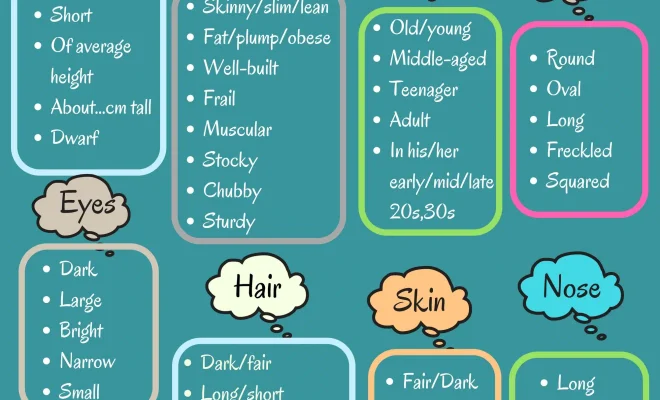3 Ways to Describe a Person’s Physical Appearance

Introduction:
When it comes to describing a person’s physical appearance, there are many ways to paint a vivid and accurate picture. Utilizing these methods not only helps in creative writing but also enhances our ability to communicate effectively in everyday conversations. This article will discuss three helpful techniques to describe someone’s looks with detail and precision.
2.Start with the Basics: Build a Foundation
The first step in describing someone’s physical appearance is to focus on the most noticeable features that give the person their unique identity. Typically, it would include attributes such as their height, build, skin color, hair color, and hairstyle. For example:
“He is a tall man with a muscular build, standing at least six feet. His skin tone is olive, and he sports a neatly trimmed black beard. His dark brown hair is short and wavy.”
Starting with these core attributes helps establish a mental image that can be refined further by examining additional features.
2.Focus on the Facial Features: Portraying Personality
Facial features make each person unique and are essential for expressing emotions. When describing someone’s face, consider elements like their eye shape and color, eyebrows, nose, lips, chin shape, or any prominent facial markings. Facial attributes clarify the person’s demeanor and make them stand out from others. For instance:
“Her bright blue eyes sparkle with curiosity and warmth beneath gracefully arched eyebrows that frame her heart-shaped face elegantly. A petite button nose sits above her full rosy lips which always seem ready to break into an infectious smile.”
By focusing on facial features, the description brings the person’s character to life.
3.Use Similes and Metaphors: Add Depth to Your Description
Similes and metaphors are powerful tools when it comes to describing a person’s physical appearance. They create vivid images by comparing one thing to another and help inject additional depth and emotion into the description. Here’s an example:
“Her raven hair falls in smooth, sleek waves that cascade like a waterfall down her back, framing her creamy porcelain skin which contrasts the eyes that rival the emerald green of an untouched forest.”
Utilizing similes and metaphors adds color and depth to the description, increasing its impact on the reader.
Conclusion:
To effectively describe a person’s physical appearance, start by focusing on basic aspects such as height, build, skin tone, and hair. Next, pay special attention to facial features to convey personality. Lastly, use similes and metaphors to enrich your descriptions and create a lasting impression. Incorporating these techniques will help breathe life into your portrayals and engage the imaginations of your readers or listeners.






